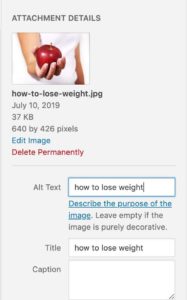It’s not a secret that blogging really does take some time and effort. Naturally, every blogger wishes to grow their traffic as quickly as possible. They know that as soon as they have that traffic coming in, their blog can and will start making them money.
Luckily for us, there are a number of things that you can do to grow your blog traffic faster. Below, you will find a list of 30 blog writing tips that will help you make your blog bigger and better in no time. Enjoy!
P.S. Don’t forget to download our FREE guide >>>7 SMART STRATEGIES TO GROW YOUR BLOG TRAFFIC FASTER!<<<
1. Keyword research
My first blog writing tip for you is about keyword research.
When I first started this blog, I had absolutely no idea what keyword research was. I also didn’t understand just how important keywords are. So as you can probably guess, my first blog posts were quite random in terms of content. They had no keywords and the topics were taken off the top of my head.
Every blogger that has been in the business for a while understands that success in this field is determined by how well you rank in Google and other search engines. Before you make any money blogging, you must first grow your traffic.
In other words, the more people find you through Google, the more traffic you get and the more successful your blog becomes. But to be found on Google, you need to write about things that people actually want to read about. And the only way to find out what people are interested in is to do keyword research.
I won’t go into the topic of how exactly to do keyword research here because of how complex it is. But you can find more information on it here.
2. Title must come first, not last
In school, I was taught that to make writing easier, you must first come up with a topic, then you do the writing, and finally, you create the title based on your core content. In blogging, this rule does not work!

In the first blog writing tip, I said that to be found on Google, your blog posts need to be carefully researched and keywords should be used. Having a keyword in your title is an absolute must!
Look at the title of this blog post “30 Blog Writing Tips That Will Make Your Blog More Successful!”. The keyword/key phrase here is blog writing tips.
What this means is that I first researched what I am going to write about. I found that people are interested in blog writing tips. I then created a title around that key phrase. And now that I know my title, I know what my blog post is going to look like and I know what keywords to focus on as I write it.
You can adjust your title after you have finished writing. But to make writing easier, I suggest that you have the title (with the keyword in it!!!) ready before you start writing.
3. Intro comes last
The introduction is arguably the most important part of any text. It should catch the attention of your reader and make them want to keep reading on. This is especially important for us – bloggers, since we want our readers to stay on our blog for as long as possible. The longer the session duration of a visitor, the better for our ranking in Google.
Writing an epic intro is not easy, especially when you don’t know what the rest of your blog post will look like. For years, I started with the introduction first, which caused me to stare at the monitor, not knowing what to scribble down.
After having shared my problem with some other bloggers, I found out that I am not the only one with this issue. The solution? Write your introduction last. Not only it’s much easier to do it at the end, but it also turns out to be a lot better in quality.
4. Come up with topics beforehand
It’s important to have a schedule for everything you do in blogging. Coming up with blog post topics also needs to be a part of that schedule.
In the past, when this blog was still new, I had plenty of ideas that I wanted to cover. I could think of one on the spot and start writing immediately. With time this became more complicated, as I had already written about so many things on the list.

Coming up with new blog post ideas today requires A LOT of time, brainstorming and research, all of which can make you exhausted mentally. My blog writing tip for you is – come up with those topics on a separate day!
Have a whole day once a month, which you dedicate to finding new things to write about and doing keyword research. It’s a lot of work, but trust me, it’s much better if you do this once a month, on a separate day from writing. Save your writing days only for writing.
5. Write at least 1000 word posts
If you study carefully Google’s search engine results, you will see that generally, those blogs that come first in the results have a lot of words in their posts. Most are over 1000 words. Some are over 5000 words. What does this tell you? Google prefers posts that are long and will rank them higher.
On the side note, try not to make long blog posts for the sake of making them long. Although longer posts usually do better, well-written short posts can outrank all of the others.
As a rule of thumb, I don’t write blog posts that are under 1000 words.
6. Grammar check on a separate day
Just like keyword research, checking the grammar and editing your blog post can take a lot of time and effort. Because of this, I suggest that you do it on a separate day from writing.
You can, of course, do it on the same day, but your eyes will be tired and you will miss out a lot of errors. Proofreading it on a different day helps you see your blog post from the perspective of a reader. You will find new mistakes and parts that need more explanation on your part.
7. Images and GIFs
Adding images and GIFs can be a great way to make your posts more attractive. It’s a blog, after all, not a scientific article.
8. Add sharable quotes
Quotes like the one you see below can be used effectively to grow your audience.
Not everyone wants to share a whole blog post, unless, of course, they really-really love it. Sharing a funny/smart quote, on the other hand, is easier and more common.
Click To TweetDon’t stumble over something behind you. – Seneca
All you have to do is find a quote and use some plugin to make it shareable. In my case, I use the Social Warfare plugin, but there are many alternatives, including a “pluginless” online one called ClickToTweet.
The whole point of tweeting quotes is that when someone tweets a quote, the plugin I use, automatically adds a link of my blog post to the tweet. This is one of those creative ways to grow traffic.
9. Emphasize and italicize
Emphasizing and italicizing text is also another way to make your blog posts more “fun” to read.

Additionally, some experts claim that emphasizing and italicizing keywords (i.e. blog writing tips) and their synonyms can help your on-page SEO.
10. Keyword in the first paragraph
If you follow SEO best practices, which you should, then you know that having your keyword in the post title is very important for SEO purposes. It helps you rank higher in Google. But that’s not all.
It’s also very important that you have your keyword somewhere at the beginning of the blog post, preferably in the first paragraph. This will automatically help the search engines understand what the post is really about.
So remember, use your keyword once in the title and a few times in the core text. Include it once in the first paragraph, if possible.
11. Add internal links
This is a very important blog writing tip. Use internal links in your blog posts!
An internal link means a link that points from one of your blog posts to another one of your blog posts. There are two reasons why we need to be using internal linking.
First of all, internal links keep the readers on your blog. They may be skimming through one of your blog posts, and then come across a link that leads to another topic, one that they are more interested in. Now suddenly, your reader didn’t just visit one page on your blog, but two. The more they stay on your blog, with the help of internal links, the better it is for you.
You may have also heard of an SEO term called “bounce rate”. Bounce rate means the percentage of people that visit only one page of your blog and leave.
For example, if 10 people come to your blog and all 10 of them leave directly from the page they visited, your bounce rate is 100%. This tells Google that your blog is boring, of poor quality, loads slowly, etc.
But if 5 of those people clicked on one of your internal links and went reading other blog posts, that means your bounce rate is now at 50%, which is great. For Google, the lower your bounce rate, the better.
The second reason why we use internal linking is to tell the search engines what our blog is about. By having links pointing from one blog post to another, we give a better picture of what our blog is about to the search engines.
12. Add outbound links
Outbound linking means having links pointing from your blog to other websites.
At first glance, outbound linking may seem like something we shouldn’t be doing. I mean, why would we promote other websites and give them “link juice”? Well, it’s a bit more complicated than that.

By using outbound links, we help search engines understand which web pages are related to which. This is good for the internet in general. But some SEO experts also claim that outbound links help you grow your own SEO as well.
Generally, when you talk about something scientific and use a link to cite the source of your claim, it adds credibility to you and your blog. Your readers will appreciate it, but also the search engines might, as the experts claim.
13. Keywords in images
As we have already covered, keywords help your blog ranking in the search engines, a lot.
But there is more than just using keywords in text. You can and should use keywords in the images that you upload to your blog posts.
For example, let’s say that your key phrase is “how to lose weight”. You are planning to add 4 images to your blog post. What you could do is use the key phrase and its synonyms in the image names and alt texts.
You take your first image, change the name to how-to-lose-weight.jpg. You then upload the image to WordPress. On the media upload screen, you edit the “Alt Text” to how to lose weight. You take the next image, and you do all of the above, except you can use a new key phrase, such as how to lose weight fast, for example.

14. Synonyms of keywords in subheadings
In the previous blog writing tip, I mentioned that using synonyms is also important for SEO. Search engines today are smart enough to see the relationship between singular and plural forms of keywords (i.e. dog, dogs), but also their synonyms (i.e. excited, agitated).
To improve your chances of ranking for a certain keyword, don’t just use the keyword itself, but also its synonyms. This creates a more complete picture for the search engines of the topic that you are writing about. This way, you may rank not only for your main keyword, but also for its other variations, which is exactly what we want.
Using keyword synonyms in the subheadings (H2 or H3 header tags) of your blog post is especially recommended. You can use the Thesaurus website to look up for variations of the keyword.
15. CTA in the middle of the text
One of the ways to grow your blog traffic is to grow your email list. Everyone who visits your blog post and leaves will probably never return. Everyone who visits your blog and gets on your email list will most-likely be a returning reader, which is awesome!
I talk about how to create your email list here.
In a nutshell, you need to make the process of collecting an email for your reader as easy as possible. I do it in 3 different ways.
- Have an email collection form on the sidebar, as I have it here ->
- Once the reader approaches the middle of the blog post, a pop-up will appear. You probably have seen it on this blog by now. It may be annoying to some readers, but statistics show that pop-ups really do help to collect those emails. Besides, it’s very easy to close them.
- Finally, I add a line of text that you see below. A user can click on it, give me their email and get a free blog traffic growing guide in return. It’s called an “ethical bribe”. By the way, it’s an awesome guide, feel free to get it as well. 😉
Download our FREE guide >>>7 SMART STRATEGIES TO GROW YOUR BLOG TRAFFIC FASTER!<<<
16. Use numbers in your titles
Studies have shown that creating a numeric title, such as “10 Ways to Rank Your Content Higher on Google” is more likely to be clicked on than a title without a number in it.
However, try not to force numbers into the title as it may just sound odd. If it fits in naturally, go for it.
17. Use questions in your titles
Another blog writing tip is to use questions in your titles that will make the reader curious.
For example, you can say, “Does making a lot of money really make you happy?” or “Is the keto diet the most effective diet out there?” or “Can blogging replace your day job? Find out now!”. You get the point. Very simple but very effective.
18. Add “Free guide” to your title
In one of my latest posts, I tried a new strategy that I saw a few other blogs use. I added the free guide that I am offering right into the title of the blog post. The title is “How to Make Money with a Blog for Beginners (+ FREE Guide to Grow Traffic!)“.
The results were outstanding! I got double the clicks on that blog post that I normally get and I also had a large flow of new subscribers. Conclusion? It works!
19. Use short paragraphs
Most of the successful blogs that I see out there use short paragraphs. The reason for this is that it’s simply easier to read when the paragraphs are short.
I know that from the standpoint of a real novel, short paragraphs would probably not look too good. But then again, we write blog posts, not books. The rules here are often different from the typical writing that you would learn in school.
20. Market your blog post to your email list
Another blog writing tip is to market your writing to your email list.
Many newbie bloggers focus on writing blog posts but they don’t advertise them once the posts have been published. This is a big mistake.

You want to grow your following. Marketing is a very big part of this. If you publish your blog post and hope that people will just find it, you are wrong. You need to do all that you can to help people find those posts. Market them in all ways possible.
As a matter of fact, marketing each blog post for me takes as long as writing and proofreading it, if not more. It’s a very important step that you should not leave out.
Now, you may be thinking that you don’t have a big list to market to. Well, that doesn’t matter. Every penny counts! Even if you have 1 person on your email list, let them know that you have published something new that they may enjoy reading. And if they do read your email and come to your blog, you have just added more traffic.
Besides, that person got on your email list because THEY WANT TO hear from you. So don’t do them and yourself a disservice by not sending updates.
Also, it’s very important to practice writing emails to your audience. Maybe it doesn’t seem that important to email just one person, but consider it as practice. If you do practice, by the time your list is made out of thousands of emails, you will be perfect at it.
21. Market your blog post on Reddit
Reddit is an amazing source for bloggers. You can search Google for different subreddits that are related to your blog post and start marketing there.
However, please follow the rules of each subreddit carefully. You don’t want to be that spammy guy that gets banned immediately. Leave links where the subreddits allow you to do so. And in those that don’t, you can reply to different threads and leave a link to your blog post if it adds value to what you are saying.
22. Market your blog post on Quora
Quora is another wonderful website that I use all the time. It’s a place to ask questions and give answers.
What I do is I find questions related to my latest blog post, and then I leave a helpful answer to those questions. At the bottom of each response, I leave a link to my blog post and YouTube video.
When I just started out blogging, Reddit and Quora were my two main sources of traffic.
23. Market your blog post on social networks
If you are a blogger, you must have a Facebook page, a Twitter profile and an Instagram account, even if you don’t like social networks. Business is business.
Every time you post something new, share it to all of your social networks accounts. That is additional traffic.
Pinterest, by the way, works really well for some blog niches, such as fashion or cooking.
24. Embed Instagram into your blog post
Embedding an Instagram post into my blog posts is also something I do every single time. Not only it can be an image that adds to your article’s topic, but it also will drive some traffic to your Instagram account that can then be driven back to your blog. Win-win scenario.
Like this:
25. Embed YouTube into your blog post
If you have a YouTube channel, then you absolutely must embed that video into your blog posts, if it fits the subject, of course. See my example at the beginning of this post.
People love to see a real person behind any blog. So seeing my face from my YouTube channel with every blog post lets them understand that this blog is “alive”. It makes the posts more personal.
26. Use your own voice
When I first started creating this blog, I had no writing style of my own. I kept copying other people, making every blog post look a little different. Soon enough, I got really tired of it. I kept thinking to myself, “can I say this here? What about this? Will this drive people away or attract them?” Finally, “screw it”, I said. I began to write from my heart.
Finding your own writing style, your own voice is very important. That is what will allow you to attract a certain type of audience. If you sound different in every post, you’ll have a hard time finding your “tribe”.
Your blog is for you to be YOU and to write the way YOU would like to write. The more you sound like you every single time, the more people you will attract. It’s true.
27. Don’t write every day
Some people will tell you to write as much as you can. Do it daily, if you need to. “Throw **** against the wall, see what sticks”, they will say. I am TOTALLY against this approach!
The fact is that today there is a lot of competition on the internet. Most blogs do exactly that – they publish poor content. You don’t want that. You want to be successful!
I write one post a week and that is more than enough. If you research your topics, your keywords, you do the writing, proofreading and marketing, you will see that there is no way in the world you can write something of good quality every single day.
If you look at some of the most successful blogs out there, you will see that most of their content is long, well-researched and has no spelling mistakes. So why should you hope that you will find success by writing something of low quality? Trust me on this one, I also started by writing really dull, short blog posts.
28. Have a schedule
In the previous blog writing tip, I mentioned that there are many parts to writing a successful blog post. Moreover, you need to be consistent with those parts if you want this thing to work long term.
Have a day for researching, a day for writing, a day for editing your blog post and a day for marketing it. If you don’t have a schedule and you try to do everything at once, you will mess up.

When I started blogging, I also had no schedule. I basically tried to juggle all of the tasks. Quite quickly I realized that I was about to burn out if I don’t do something about it. I ended up creating daily goals and a schedule for myself. That solved the problem once and for all.
29. Don’t be afraid to edit out the unnecessary
Earlier I mentioned that long blog posts usually do better than short ones. But if you do write longer blog posts, be careful that you don’t leave in a lot of unnecessary fluff.
Every time you edit your posts, and you see that something sounds weird, don’t be afraid to remove that part altogether. Don’t run after the number of words. At the end of the day, people want to read well-written, interesting articles, not long ones.
30. Use stories from your life
My last blog writing tip to you, my friend, is to use stories from your life whenever possible.
Earlier I said that people love to visit blogs that feel more personal, that have a real person behind them. There are simply too many blogs out there that look like they were written by nobody or by a ghostwriter (which they often are).
The more personal your writing is, and the more stories and examples you use from your own life, the better. People will have something to relate to, something to connect to. You readers will appreciate your honesty and sincerity, I guarantee you.
These were the 30 blog writing tips for now! Hopefully, you found them helpful. And if you haven’t yet downloaded my free guide >>>7 SMART STRATEGIES TO GROW YOUR BLOG TRAFFIC FASTER!<<<, then I recommend that you do so now! The things I put in there are the things I personally use every single time I publish a new blog post.
Thank you for stopping by and good luck!
Please click below to subscribe and to follow us on social media:
Click here to follow us via E-mail!
Click here to follow us on Facebook!
Click here to follow us on YouTube!
Click here to follow us on Instagram!
Click here to follow us on Twitter!
Click here to join our Facebook group!


 15 Best Inspirational Movies That Teach to Never Give Up
15 Best Inspirational Movies That Teach to Never Give Up
 50+ Best Self-Help Books That Will Change Your Life Forever
50+ Best Self-Help Books That Will Change Your Life Forever
 Short Motivational Stories of Failure and Success That You Must Know
Short Motivational Stories of Failure and Success That You Must Know
 10 Examples Where the Power of Positive Thinking Kicks Ass!
10 Examples Where the Power of Positive Thinking Kicks Ass!
 What to Do When Someone Is Better Than You? – Dealing with Jealousy
What to Do When Someone Is Better Than You? – Dealing with Jealousy

Leave a Reply